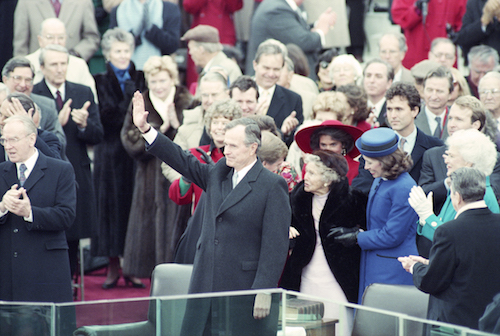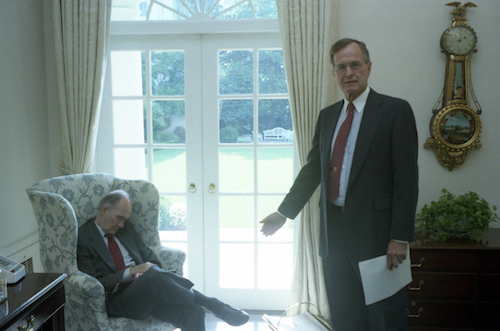Communiqué
George H.W. Bush’s team navigated international crises in STATECRAFT: THE BUSH 41 TEAM – August 4 at 10 pm
< < Back toSTATECRAFT: THE BUSH 41 TEAM
Tuesday, August 4 at 10 pm
Examine the presidency of George H.W. Bush and his foreign policy team’s expertise as they navigated international crises like the fall of the Berlin Wall, reunification of Germany, collapse of Russia, the Panama invasion and the invasion of Kuwait.
“The more I study the end of the Cold War,” says historian Jeffrey Engel at the beginning of Statecraft, “the more amazed I am that we’re all still alive.”

20 January 1989
Photo Credit: George H.W. Bush Presidential Library and Museum
During his presidency, President Bush devoted much of his time to foreign affairs, an area over which Presidents generally have more latitude than they do with domestic affairs. In his first inaugural address, Bush spoke of unity between the executive and legislative branches in foreign affairs, presenting a united front to the rest of the world and referring to a time when “our differences ended at the water’s edge.” He also put together a team of advisers, including National Security Adviser Brent Scowcroft, Secretary of State James Baker, Secretary of Defense Dick Cheney, and chairman of the Joint Chiefs of Staff Colin Powell, who generally worked well together. President Bush approached foreign affairs with his characteristic conservatism and pragmatism. He did not rush into new actions or policy changes but gave himself time to consider the administration’s policies. When he acted, he did so with firm conviction and determination. His past experiences gave him significant experience in foreign affairs, and he relied on the many contacts within the international community he formed as ambassador to the United Nations, U.S. envoy to China, director of Central Intelligence, and Vice President.

26 June 1990
P00142-22 President Bush and Lee Atwater play the guitar at the Celebration for Young Americans, DC Armory, Washington, DC,
21 Jan 89.
Photo Credit: George Bush Presidential Library and Museum
Statecraft examines the Cold War struggle between the Soviet Union and the United States and how the foreign policy team of President George H. W. Bush guided the country. The film explores the challenges of a series of major upheavals through the recollections of the individuals who faced them. Finally, it considers the legacy—both positive and negative—of this consequential American presidency.
George Herbert Walker Bush belongs to a political dynasty; he sits in the middle of three generations of politicians, including his father Prescott, a senator from Connecticut; his son Jeb, former governor of Florida; and his son, George Walker, the 43rd President of the United States. In fact, George H. W. and George W. are only the second set of father and son to become President. (John Adams and John Quincy Adams were the first.)

